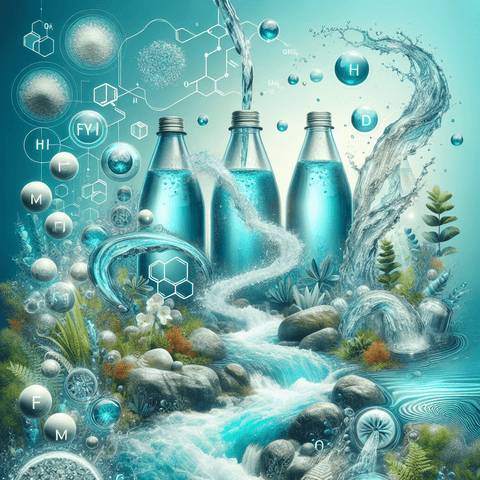Magnesium in Water: Its Role and Importance in Nutritional Supplements
Magnesium is a vital mineral required by every cell in the human body. Involved in over 300 enzymatic reactions, this essential nutrient plays a pivotal role in energy production, muscle and nerve function, and the maintenance of a healthy immune system. It's also crucial for cardiovascular health and bone integrity. Although magnesium is found in various foods such as leafy greens, nuts, seeds, and whole grains, deficiency remains widespread globally due to modern agricultural practices and dietary patterns that often lack sufficient magnesium.
One lesser-known but potentially significant source of magnesium is drinking water. While the mineral content of water varies by source, magnesium can contribute a non-negligible proportion of daily intake—especially when water is consumed in adequate quantities. Supplementing magnesium through water offers a passive and convenient method to enhance overall magnesium status without relying solely on dietary changes or tablets.
Natural water sources contain minerals because of their interaction with soil and rocks. As groundwater or spring water passes through mineral-rich terrains, it can accumulate varying levels of magnesium. These naturally dissolved minerals tailor the unique chemical profile of each water source. In recent years, attention has turned toward dissecting these profiles and assessing their relevance in tackling common nutritional deficiencies. Particularly in areas where diets may fall short, magnesium-enriched water becomes especially relevant as a supplemental pathway.
This has prompted scientific interest in analyzing the nutritional quality of drinking water, as well as consumer curiosity. People not only want to stay hydrated but also optimize their health through functional beverages. As a result, the market for mineral-rich bottled waters has expanded, with many options advertised for their higher magnesium content.
Dietary supplements continue to play a critical role in bridging gaps in micronutrient intake. For individuals who struggle to meet daily magnesium needs through food and water alone, magnesium supplements are a reliable and efficient alternative. Products such as magnesium citrate or magnesium bisglycinate offer high bioavailability, while others are blended for specific functions like bone support or muscle recovery. Hydration combined with proper supplementation can greatly enhance the body's magnesium reserves.
Scientific recommendations for magnesium intake vary by age and gender, but generally fall between 300 to 400 mg per day for healthy adults. Ensuring a balanced intake not only supports performance and wellness but also contributes significantly to long-term health outcomes. And with water as an achievable contributor, understanding which types of water provide the most magnesium is an essential step toward optimized living.
Magnesium Levels in Natural Water: What You Need to Know
Natural water sources—including rivers, lakes, springs, and even shallow aquifers—serve as the foundational supply for drinking water systems across the globe. These sources absorb a medley of minerals, including magnesium, as water percolates through layers of soil, rock, and sediment. The content of dissolved minerals in such water is often referred to as its “hardness,” with magnesium and calcium being the primary contributors. However, magnesium concentrations in natural water sources vary widely due to geological and geographical factors.
To put it into perspective, the magnesium concentration in fresh waters can fall anywhere between 1 mg/L to over 100 mg/L. In general, waters flowing through limestone (calcium carbonate) tend to be lower in magnesium, whereas those in volcanic or dolomitic rock regions may have higher levels. For example, areas in parts of Eastern Europe, including the mineral-rich springs of Hungary and Slovakia, boast magnesium concentrations as high as 70 to 150 mg/L in their natural waters. In contrast, rain-based freshwater sources or glacial runoff streams may show levels as low as 1 to 10 mg/L.
This geographical dependency is one of the main reasons why magnesium content can differ so drastically from place to place. The composition of the earth’s crust in a region, along with rainfall and human activities (such as agriculture and industry), all contribute to how much magnesium ends up in surface and groundwater. Additionally, seasonal factors and water flow rates can alter these mineral concentrations over time. High-flow river systems generally exhibit more diluted magnesium content compared to slower-moving or still water bodies that interact longer with magnesium-rich sediments.
Climatic elements also play a part. In arid and semi-arid zones, evaporation rates can increase the concentration of minerals due to water loss, making magnesium more prevalent per liter of water. Meanwhile, tropical areas with heavy rainfall might experience dilution effects that reduce mineral concentrations unless the terrain strongly contributes these elements.
Given the importance of regional variability, many national and international agencies have conducted hydrogeological surveys to profile the typical magnesium content of water in different regions. For instance, the World Health Organization (WHO) reports average magnesium concentrations in drinking water to be around 10–35 mg/L, though these statistics encompass an expansive range of developing and industrialized nations.
Understanding these patterns can significantly inform individual choices, particularly in areas where tap water naturally lacks essential minerals. Identifying magnesium-rich natural water sources becomes a conscious health decision, especially when integrated with comprehensive nutritional strategies, including targeted supplementation through top-quality magnesium products.
Mineral Water Magnesium Content: A Natural Boost for Your Magnesium Intake
Mineral water occupies a unique space in the broad spectrum of drinking water options. Defined as water sourced from an underground reservoir and bottled at the source, mineral water contains a consistent level of minerals that are naturally present. Unlike tap or municipal water, which may be chemically treated or filtered, mineral water retains its original mineral profile—including magnesium content—which makes it particularly beneficial for those aiming to boost their magnesium intake through simple hydration.
The classification of mineral water is often governed by regional or national regulatory agencies. In the European Union, for instance, mineral water must be bottled at the source under hygienic conditions and cannot undergo treatments that alter its chemical composition. That means consumers can trust the consistency of the listed mineral content on the label, including magnesium concentrations. The Food and Agriculture Organization (FAO) categorizes water as “magnesium-rich” if it contains more than 50 mg/L of magnesium.
Many commercially available mineral waters exceed this guideline. Brands such as Gerolsteiner (Germany) offer up to 109 mg/L of magnesium, while others like Rosbacher or Apollinaris provide levels between 40–95 mg/L. Slovakian and Italian mineral waters—Baldovská and Ferrarelle, respectively—also maintain magnesium levels that contribute meaningfully to daily requirements. With a typical bottle containing 1 to 1.5 liters, just one serving can yield 10–20% of the recommended daily intake for magnesium.
Incorporating mineral water into your diet offers numerous benefits. For individuals who suffer from digestive issues related to high-dose supplements, water serves as a gentler ingestion method. Furthermore, drinking magnesium-rich water promotes natural hydration while addressing micro-deficiencies more subtly and continuously. It’s also an excellent option for those with restrictive diets (such as vegan, paleo, or low-dairy) who may lack key nutrients from food sources alone.
Consumers should pay careful attention to labeling when choosing mineral water for magnesium content. Reputable brands list the precise amounts of all major minerals per liter, including magnesium, calcium, bicarbonates, sodium, and sulphates. Remember that not all mineral waters are equal—some may be more focused on calcium or bicarbonates, offering minimal magnesium. Select those explicitly labeled as “rich in magnesium” or with transparent mineral analysis data.
Adding mineral water to your daily regimen can be an effortless enhancement to your nutrient intake. However, for individuals requiring higher levels of magnesium—such as athletes, pregnant women, or people with medical conditions—mineral water should be seen as complementary. Pairing it with a thoughtfully chosen magnesium supplement ensures that you meet your daily goals effectively and safely.
Magnesium Concentration in Spring Water: Nature’s Own Source of Essential Minerals
Spring water is another natural hydration source that can significantly contribute to magnesium intake. Sourced from underground aquifers, spring water rises naturally to the earth’s surface and is often collected for bottling with minimal processing. Thanks to this direct interaction with geological layers, it picks up an array of minerals—magnesium among the most important for health.
The mineral profile of spring water varies according to subterranean rock compositions and hydrological activity. In regions with dolomite or serpentine rocks, magnesium concentrations tend to be higher, often surpassing 50 mg/L. Famous examples include waters from springs located in Central Europe, the Caucasus, and select volcanic regions in Asia and South America. These naturally elevated magnesium levels make spring water a wellness booster beyond just hydration.
Some of the most recognized high-magnesium spring waters globally include Hepar (France) with around 110 mg/L, Donat Mg (Slovenia) boasting over 1000 mg/L, and Contrex (France) containing about 74 mg/L. These are among the few natural sources that, through normal consumption, can meet or exceed one-third of daily magnesium needs. In fact, Donat Mg is often recommended under physician supervision for addressing mild to moderate hypomagnesemia due to its exceptionally high concentration.
The mineral-rich profile of spring water doesn’t just benefit magnesium seekers; it offers a holistic set of electrolytes including calcium, potassium, and sulfate, supporting a full spectrum of metabolic activities. Unlike artificially fortified waters, natural spring sources provide these elements in bioavailable forms, increasing their utility and effectiveness within the body.
Like mineral water, spring water is bottled close to its natural origin and usually does not go through chemical processing, although it may be filtered to remove particulate matter. When selecting a spring water brand, ensure the packaging clearly displays a full mineral analysis. Bottled spring waters that originate from volcanic or mountainous terrain tend to show the highest levels of naturally occurring magnesium.
Given this rich nutrient offering, spring water stands out as one of the top choices for anyone looking to increase their magnesium intake without pills or powders. It is especially ideal for families and children, as it provides mineral support in a delicately balanced and safe form. Columns dedicated to magnesium benefits often underscore spring water as a practical yet underutilized dietary source, particularly suited for everyday hydration.
When combined with a nutrient-dense diet and supplementary magnesium products when needed, spring water offers a seamless way to build and maintain optimal magnesium levels without medical intervention.
Drinking Water Magnesium Comparison: Which Types Offer the Most?
When evaluating drinking water options, it’s helpful to compare typical magnesium concentrations among tap water, filtered water, bottled water, and mineral water to identify the most effective source for increasing your intake. Each type has distinct properties, mineral content, and benefits, influenced heavily by its source and treatment processes.
Tap water, regulated by municipal authorities, often originates from reservoirs, rivers, or lakes. The magnesium content in tap water ranges between 1 to 50 mg/L depending on the region’s water source and treatment methods. Magnesium might be lost during purification, softening, or chemical disinfection. Softened water, for instance, replaces magnesium and calcium ions with sodium ions, significantly reducing its potential as a dietary magnesium source. In magnesium-rich geological zones, however, unsoftened tap water may contribute modestly toward daily intake.
Filtered water—produced via household or industrial filtration devices—typically aims to remove contaminants, bacteria, and excessive hardness. Unfortunately, aggressive filtration methods like reverse osmosis or distillation also remove beneficial minerals, including magnesium. While some modern filters preserve or even reintroduce essential minerals, most off-the-shelf systems produce water that is virtually magnesium-free unless the filtration pitch specifically addresses mineral maintenance.
Bottled water varies more drastically. Standard bottled water, often equivalent to filtered tap water, may contain very low levels of naturally occurring minerals. Mineral water and spring water stand apart due to regulatory oversight and source-specific mineral content. Mineral water wins consistently in magnesium density—average levels range from 30–130 mg/L, with high-end options exceeding 200 mg/L (in the case of therapeutic brands like Donat Mg).
Here’s a general comparison of magnesium concentration in popular water types:
- Tap Water: 1–50 mg/L (region-dependent)
- Filtered Water: 0–10 mg/L
- Bottled Purified Water: 1–50 mg/L
- Mineral Water: 30–130+ mg/L
- Spring Water: 5–150+ mg/L
Each option serves different hydration needs, but for maximum magnesium benefit, high-quality mineral or spring waters are superior. When water alone is not enough, particularly for those with higher metabolic demands, magnesium-rich supplements become a crucial addition to daily health regimens, ensuring sufficient intake regardless of local water conditions.



